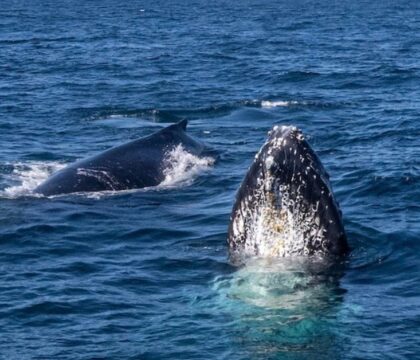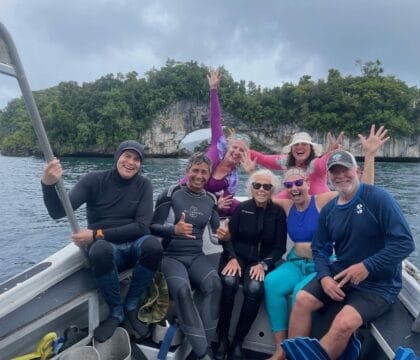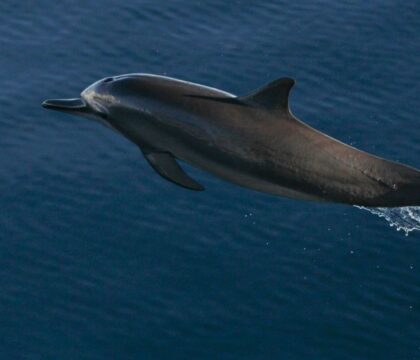April 5, 2023 • Blue Habits Tips
Concern about the impact of sunscreen on coral reefs, and the need for reef safe sunscreen, has been growing since 2008 when the first study was published showing a direct link between coral mortality and ingredients found in sunscreens. This is especially problematic in areas with high levels of tourism. The scale of the problem is significant. Scientists estimate that between 6,000 and 14,000 tons of sunscreen—the equivalent of 25 to 60 million bottles—wash off of snorkelers and swimmers into coral reef environments each year. At the same time, ocean and coastal tourism is growing, and it is estimated that more than a billion people worldwide will be visiting oceans for recreation and tourism by 2020.
Since that initial study, many more studies have followed and have identified two chemicals found in sunscreens that cause direct harm to corals: oxybenzone and octinoxate. Beyond sunscreen, these ingredients are found in lipsticks, moisturizers, and other cosmetics, and they are readily absorbed into the blood (and subsequently found in human urine). All products containing these chemicals, not just sunscreens, should be avoided when you are near marine environments. In fact, some experts believe that the wash-off of these chemicals during showering and swimming plays a bigger role than climate change in damaging coral reefs. While oxybenzone and octinoxate are the most well-studied culprits, new research is finding that other chemicals in sunscreens may also be harmful to coral reefs, in particular octocrylene, 4-MBC, benzophenone-3, methoxycinnamate and butylparaben. Here is a vetted list of all of the known pollutants that may be in your sunscreens and other skin/hair care products that should be avoided.
Chemicals in traditional sunscreen make corals more susceptible to bleaching. © The Ocean Agency
As snorkelers, divers, and part of the community of people who wish to protect coral reefs, we need to educate ourselves about all the ways in which we can reduce our impact on these diverse and productive ecosystems. While the recent bans of certain sunscreens in Hawaii and in other places are a step in the right direction, and will help reduce the prevalence of “non-coral friendly” sunscreens in areas with high volumes of tourism, this alone is not enough.
So the question most of us will want to know the answer to is: “What can I do?”
To begin to answer this, we’ve put together the following recommendations for reef-safe sun protection, as part of our larger effort to build ocean-friendly behaviors—Blue Habits—among nature travelers.
Reef Safe Sunscreen & Sun Protection: Our Recommendations
First, it is important to acknowledge that protecting yourself from ultraviolet solar radiation, a well-known risk factor for skin cancer is very important. Snorkelers, divers, surfers, boaters, and beachgoers should all take measures to reduce their risk, and reef safe sunscreen does serve as an important tool in that effort. Our recommendations:
1. Cover Up
The best thing that you can do is to first reduce your need to use sunscreen by covering up. Wearing rash guards, dive skins, wetsuits, and sun shirts, as well as using hats, sunglasses, and sun Buffs will all help to reduce the amount of area of your body that you need to apply sunscreen to, and thus reduce the amount of sunscreen you need to apply. Many companies also rate their clothing with an Ultraviolet Protection Factor, or UPF, which is similar to sunscreens’ SPF numbers. Clothing is considered as effective as sunscreen on the parts of the body it covers.
Rash guards, dive skins, and wetsuits reduce the need for sunscreen altogether. © The Ocean Agency
2. Choose a Reef Safe Sunscreen
When you do need to use sunscreen, or for areas that can’t be effectively covered with clothing, be aware that there are two types of sunscreen to choose from:
- Chemical sunscreens: Products that frequently contain the absorbable and coral harming ingredients mentioned above. It is best to avoid these.
- Physical sunscreens (also known as mineral or inorganic sunblocks): Products that use zinc oxide and titanium dioxide and are considered “safe” for use around coral reefs.* There is some new evidence suggesting that titanium dioxide may be safer for corals than zinc oxide. These are the best choice.
* It is important to note that you should use mineral sunblocks that are “non-nano” in size, because mineral sunblocks that have particle size below 100 nanometers can be ingested by corals.
As a consumer you should also try to stay up-to-date with the latest developments related to sunscreen research. The ban of certain sunscreens in Hawaii along with the new research showing the harmful impacts of current sunscreen products on corals is leading companies to develop new reef safe sunscreen products. As these new products come on to the market, the more you know about them and the more you support them through your purchases, the more likely we will be start having more truly “reef safe” products available to us.
One of our favorite reef safe sunscreens is Stream2Sea – they take care of your skin and also our planet! And you can use discount code “OS BlueHabits” for 10% off.
Learn More About Reef Safe Sunscreen
To learn more about the products you might be using that could harm coral reefs here is a list of nearly 600 sunscreens sold in the U.S. that contain oxybenzone, including products by Hawaiian Tropic, Coppertone, and Banana Boat, as well as 172 facial moisturizers, 111 lip balms, and 81 different types of lipstick.
You can read more about the issue of sunscreen and coral reefs through the following articles:
- Can We Create Sunscreen That Protects Both Humans and Coral Reefs? | Smithsonian.com—July 16, 2018
- The Truth About ‘Reef Safe’ Sunscreen | Consumer Reports—July 10, 2018
- Most Sunscreens Can Harm Coral Reefs. What Should Travelers Do? | New York Times—February 2, 2018
- Hawaii is Banning Sunscreens that Kill Coral Reefs | Vox—July 2, 2018
Beyond Sunscreen: Blue Habits
Beyond our recommendations for reef safe sun protection, there are a number of ways that you can reduce your impacts on ocean health in your daily life and during your travels. For more information about other ways to contribute to healthy oceans through your consumer choices, join our growing global community for tips and inspiration.




